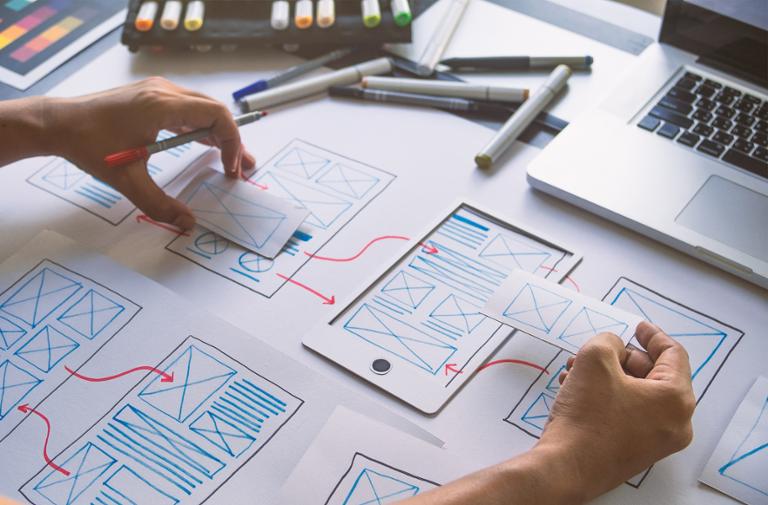When UX (user experience design) and UI (user interface design) are done right, they feel totally natural to the user. For years, Apple was considered a champion of UI and UX, although the average iPhone user probably couldn’t tell you why interacting with their iPhone or iPod felt so good; they just felt delighted by how the apps and screens worked (whether Apple adheres to these rules these days is an open question, however).
However, it’s sometimes difficult to convince companies to shell out a lot of money for competent UI and UX designers. When confronted with a tight budget for next year, a CEO might opt to hire more salespeople in lieu of professionals who make a software interface delightful. But as Apple shows, good UI and UX can help elevate a product to best-in-class—ensuring repeat customers, lots of sales, and more. It's especially vital in a mobile context, where small screens put a premium on effective design.
(As demonstrated by some very high-profile cases, good UX can mean the difference between safety and disaster. Remember, it's always important to isolate "mission critical" buttons and functionality from the main "flow," just in case someone hits something by accident.)
The good news: more companies are recognizing the need for UI and UX designers, which is why job growth for these professionals is expected to rise 14.9 percent over the next 10 years. At the moment, according to analytics platform Burning Glass, the average time required for filling a UI or UX position is 41 days—pretty high, and indicative of strong demand. So is the average median graphic designer salary of $98,972.
UX and UI Designer Definitions and Skills
People use UI and UX interchangeably, but they’re actually different. UI is what the user sees on a screen: the icons, text, colors, backgrounds, and any moving elements (such as animations). In this way, UI overlaps quite a bit with graphic design, and follows a lot of the same principles; graphic designers' education and independent-project backgrounds can often apply well to UI work.
UX, by contrast, is the study of how the user moves through all those elements that the UI folks have designed. UX designers are concerned with flow, and how much friction users experience as they interact with the software (and the hardware).
To reduce the definitions as much as possible: UI handles the “look,” and UX handles how it all “works.”
In order to achieve their respective goals, both UI and UX designers spend a lot of time talking to users (hello, focus groups!) and watching over their shoulders as they interact with prototypes. Speaking of which, these designers create tons of prototypes in the course of a given project—everything from crude wireframes all the way up to polished versions. With the evolution of augmented reality (AR) and virtual reality (VR), the complexities and pressures on UX and UI designers will only increase in coming years.
As you can imagine, good UI and UX designers have a lot of skills and experience. According to Burning Glass, some 88.9 percent of folks in these disciplines have a bachelor’s degree. But which skills do they specifically need?
Burning Glass, which analyzes millions of job postings across the county, does a great job of breaking down skills into discrete categories:
Distinguishing skills (are advanced skills that truly differentiate candidates applying for various roles. As you might expect, there’s a lot of education and training necessary to master these.
Defining skills are the skills needed for day-to-day tasks in many roles.
Necessary skills are the lowest barrier to entry; they are also skills that are often found in other professions, providing a springboard for people to launch into a career in UI/UX.
With all that in mind, here’s the skills breakdown:
If you go by this list, one of the biggest barriers to entry is the Adobe suite of software products—once you’ve mastered those, you’ll have the ability to handle many of the basic tasks related to UI and UX design. Knowing the basics of web and software development: also vital.
In order to advance further in a UI or UX designer career, you’ll need to master user research, prototyping, and the fundamentals of good design. Those who climb to the top of the ranks—who truly distinguish themselves—have those skills that allow them to approach design challenges in a holistic way: design thinking, data visualization (which often means working with data science teams), and so on. (It also helps to learn Syntactically Awesome Style Sheets (SASS).)
There's also a vital need for "soft skills" such as collaboration and communication. Designers must work with developers and other team members who will help execute the overall vision; without empathy and a willingness to be flexible, a project could quickly go off the proverbial rails.
UX and UI Designer States and Companies
As you might expect, big states with a lot of economic activity (and a lot of companies that build software) are the biggest hirers of UX and UI designers. California, Washington, New York, and Massachusetts all pay six-figure median salaries to these professionals—which is fortunate, because the cost of living in these states is often really high. Check out the full list:
And here are the companies hiring the most UI and UX designers in 2019 (so far). Many of these are tech companies such as Amazon and IBM, which makes sense—their businesses are based on users interacting with software.
If you’re interested in UI and UX design, it’s clearly a strong market at the moment. Just make sure that you have the right mix of skills—and that you listen to what users really need. A solid design sense, combined with “soft skills” such as empathy, can lead you to create UI and UX that’s truly magical.
Now that you understand the necessary skills, here's what you need to know about what your UX designer salary should be.



